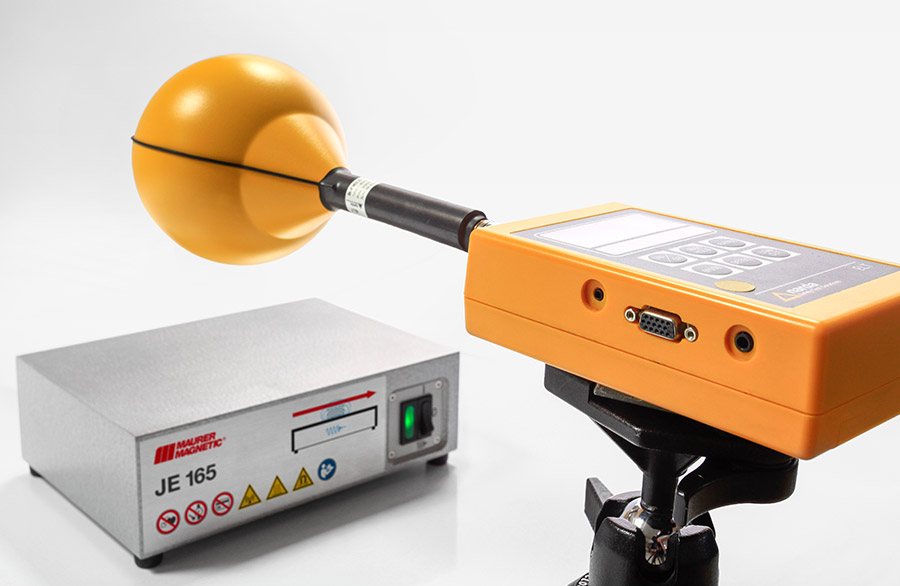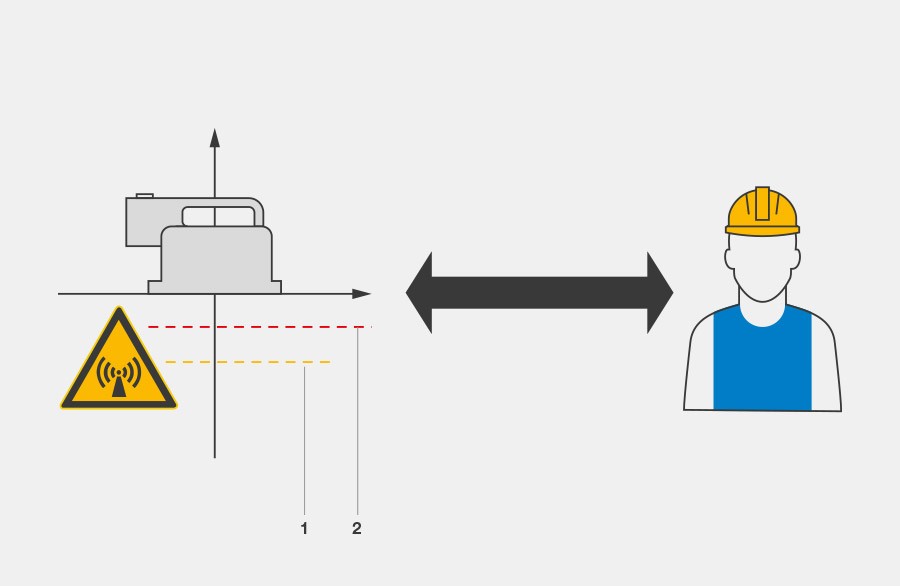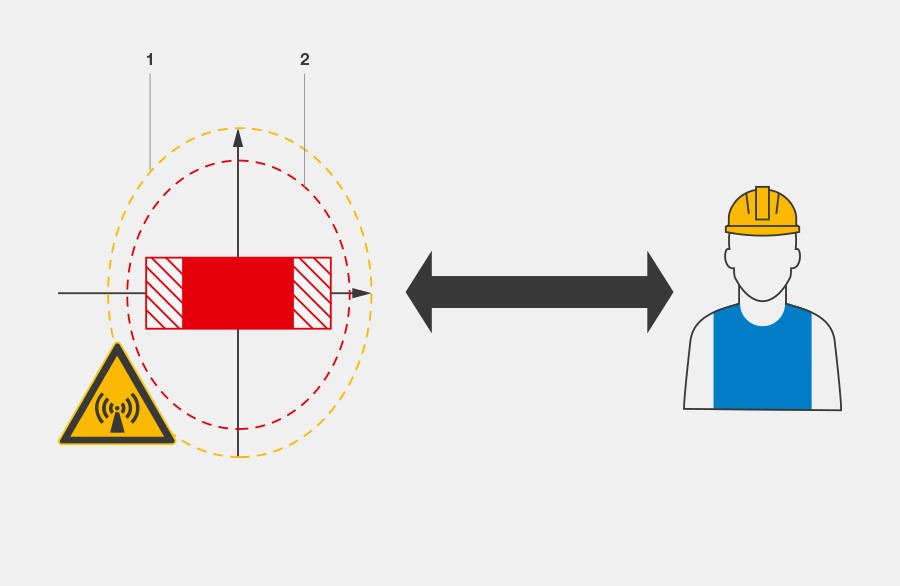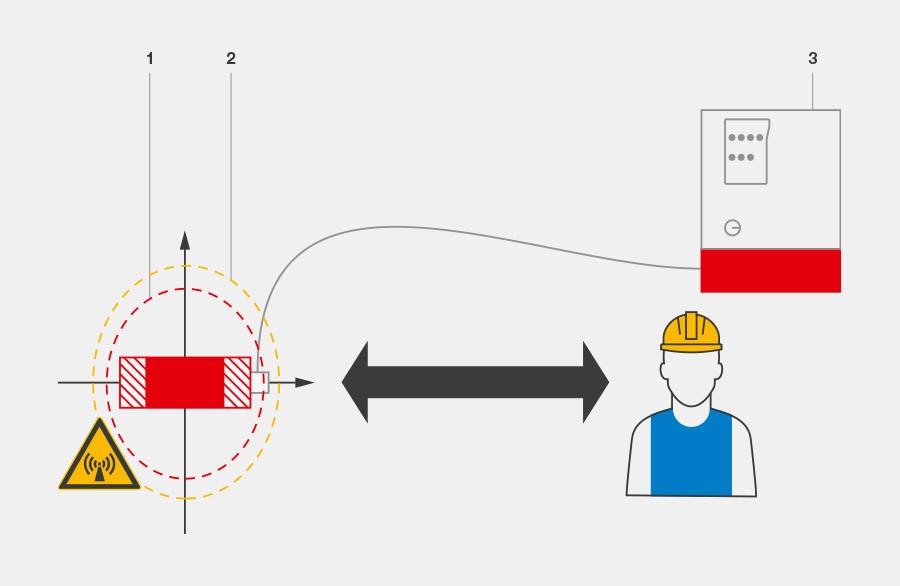Health and safety while demagnetising
This page provides an overview of health and safety guidelines and regulations regarding the electromagnetic fields generated during demagnetisation.
Damage and dysfunction mechanisms
Health and safety in relation to non-ionising radiation covers frequency ranges of up to 300 GHz. Demagnetising devices are normally operated in the low-frequency range (mains frequency of 50/60 Hz or lower). If an alternating magnetic field flows through an electrically conductive object such as the human body, this causes eddy currents in the body. If these currents are strong enough, they can stimulate nerves and muscles or affect other biological processes such as energy absorption in the tissue.
It is possible to differentiate between sensory dysfunctions and health effects with regards to these biological effects in the body:
- Sensory dysfunctions describe the effect of magnetic fields on the human nervous system. These dysfunctions are temporary.
- Health effects describe verifiable health impairments for the exposed person or their offspring.
Sources and bases for damage and dysfunction mechanisms:
- Swiss Research Foundation for Electricity and Mobile Communication – Constant magnetic fields and low-frequency alternating fields [Gleichfelder und niederfrequente Wechselfelder]
- World Health Organisation: The health effects of electromagnetic fields
- Information page from the British grid operator National Grid plc
Maurer Magnetic demagnetisation systems
All demagnetisation machines supplied by us do not radiate any magnetic fields that are harmful to people.
The statutory limit values vary in different countries. These are discussed, considered and implemented in our designs.
Guidelines
Various public and private bodies have published guidelines and limit value recommendations to protect people’s health and safety in the public and private sectors.
Overview of national limit values
| Location | Health and safety | Personal protection | Implants |
| ICNIRP 1998 | ICNIRP health and safety | ICNIRP public | |
| ICNIRP 2010 | ICNIRP health and safety | ICNIRP public | |
| EU | 2013/35/EU | EU 1999 | |
| Germany | DGUV-V 15 | 26th Federal Immission Control Ordinance [BImSchV] | BGI/GUV-I 5111 |
| Switzerland | SUVA | NISV | |
| USA | No limit values at state level. Some federal states have guidelines. [1] | ||
| United Kingdom | The Control of Electromagnetic Fields at Work Regulations 2016[2] | ICNIRP 1998 | |
| Other countries | http://www.emfs.info/limits/world/ | ||
[1] http://www.emfs.info/limits/limits-usa/
[2] http://www.emfs.info/limits/limits-organisations/regulations-2016/
ICNIRP
The most relevant guidelines come from the International Commission on Radiological Protection. The ICNIRP is an international commission for researching the effects of non-ionic radiation. It draws up guidelines with limit values. These guidelines are only recommendations but are used by many states and organisations as the basis for national and international guidelines and standards.
The ICNIRP guidelines from 1998 are the most wide-ranging; many states and organisations use them as a basis. A revised version was published in 2010 and Germany and the EU use this as a basis. In the typical demagnetisation frequency range (0–50 Hz), the limit values in the 1998 guidelines are lower when compared to those from 2010.
The ICNIRP guidelines differentiate between public exposure and health and safety. The limit values for public exposure are around 5 times lower than the limit values in the workplace. These limit values apply to whole-body exposure. This means that the field is averaged over the entire body.
EU: Health and safety directive 2013/35/EU
Directive 2013/35/EU was published by the European Council and the council for the protection of the health and safety of workers from the risks related to physical effects (electromagnetic effects). This directive specifies minimum requirements for protecting workers against actual or possible health and safety risks due to the effects of electromagnetic fields during their work. The minimum regulations specified here are part of an agreement of the individual nations in the EU. They are obligated to adjust their national laws and regulations to these minimum requirements, although individual Member States can pass their own, stricter guidelines.
Directive 2013/35/EU is based on ICNIRP 2010 and differentiates between a low action level, high action level and limb exposure:
- Low action level: Exposure limit values for sensory dysfunctions. These are noticeable for sensitive people and to be avoided by risk groups (people with pacemakers, implants, etc.).
- High action level: Exposure limit values for health effects. A possible health risk with continuous, long-term exposure. To be justified and clarified in more detail when working at fixed workstations.
Germany: DGUV V-15/BGV B11 Health and safety
The German statutory accident prevention insurance regulates health and safety for all areas in which electrical, magnetic or electromagnetic fields are used. The regulation defines the permissible values for evaluating exposure (effect of the electromagnetic field on people) and the measurement and evaluation procedure. The Accident Prevention & Insurance Association regulation for health and safety (BGV B11) is identical to DGUV V-15.
This guideline is based on ICNIRP 2010 and differentiates between exposure area 2, exposure area 1, high exposure areas and limit values for extremities.
- Exposure area 1 is the area that comprises controlled areas and areas in which the mode of operation or the dwell time ensure that exposure above the permissible values for exposure area 2 only occurs temporarily. Exposure area 1 corresponds to a production environment for example.
- Exposure area 2 is the area that comprises all company areas unless they are to be assigned to exposure area 1, the high exposure area or the danger zone. Exposure area 2 corresponds to an office environment for example.
- The high exposure area is a controlled area in which the values of exposure area 1 are exceeded.
- Extremities: Limit values may be exceeded by a factor of 2.5 for extremities.
Switzerland: SUVA
The limit values correspond to the reference values for the workplace in the ICNIRP guidelines from 1998.
United States of America: no guidelines
Implant protection
Medical implants are subject to regulations and risks due to foreseeable environmental conditions must be minimised (90/385/EEC). Therefore, no dysfunctions due to electromagnetic radiation below the limit value defined in ICNIRP 1998 are to be expected. However, the safety distances for a specific case should be determined by contacting the manufacturer of the implant.
In Germany, the German accident prevention insurance publishes specific limit values for implants (BGI/GUV-I 5111).
BGI/GUV-I 5111
BGI/GUV-I 5111 is the German accident prevention insurance and evaluates the influence of the magnetic field on pacemakers and similar devices. The limit values apply to people with these devices.
Personal protection
In certain cases (pregnancy, public accessibility of the demagnetiser, etc.), guidelines and exposure limit values for public areas are applied.
The following guidelines and recommendations take the limit values from ICNIRP 1998:
- EU 1999
- Germany 26th Federal Immission Control Ordinance [BImSchV]
- NISV (ordinance on protection against non-ionising radiation)
Examples for exposure areas for different conventional demagnetisers (Germany/EU)
For an application-related statement regarding demagnetisation, the health and safety limit values for Germany are considered.
These limit values are divided into different exposure areas. The limit values are specified in table 5. Greater safety distances must be adhered to in other countries with different limit values according to ICNIRP 1998.
The measurements for the examples were performed using a Narda ELT-400 measuring device. The following probes were used to determine the safety distances:
- Extremities: 3 cm2probe
- Whole-body exposure: 100 cm2
Tabletop unit
The magnetic field of the tabletop devices is discharged directly from the surface. The limit values are therefore measured from the surface.
Since the measurement is averaged over the entire volume of the probe, the safety distance for whole body exposure is smaller despite the significantly lower limit value. However, we recommend adhering to the greater safety distance.
Conclusion
The permissible limit values are exceeded if the parts to be demagnetised are pulled over the plate by hand. To adhere to the limit values, the distance of the user and their extremities from the demagnetisation system must be increased. This can be achieved by automation or auxiliary equipment.


Manual device
The HE2 manual demagnetiser that was used generates a low-volume stray flux. The evaluation was performed based on the limit values for limbs in the vicinity of the handle using the 3 cm2 probe. The measured values in the vicinity of the handle are below these limit values.

Conclusion
As long as the effective area on the underside of the demagnetiser is not touched, the limit values for workers according to DGUV-V 15 are not exceeded.
Air coil
The magnetic field generated by the air coils flows around the coil. Therefore, the defined safety distances around the coil must be adhered to.

Conclusion
If the person remains close to the coil, the defined limit values are exceeded. A handling unit (such as a conveyor belt) must be provided for the work to conform to standards.
Maurer Degaussing® pulse demagnetiser
Occupational safety with the Maurer Degaussing® technology
Safety through distance
The Maurer-Degaussing® pulse demagnetiser follows the process detailed below:
- Positioning the component in the coil
- Triggering demagnetisation via the control panel on the power module
- Demagnetising the component (within 7 seconds). The maximum field strength occurs within the first second after starting. The field strength then reduces quickly.
- Removing the demagnetised component.
Health and safety can be ensured by positioning the power module outside the coil’s exposure area.

Protection by shielding
Maurer Magnetic offers shielding chambers developed in-house as an option for the demagnetisation systems. The demagnetisation coil is positioned in the shielding chamber and the exposure is reduced.

By installing the coil in a shielding chamber, the safety distances decrease and interference on adjacent processes is reduced.
Optional shielding chamber
Maurer Magnetic offers highly efficient, patented shielding chambers as an option for the demagnetisation systems. The demagnetisation coil is positioned in the shielding chamber and the exposure is reduced – in addition to results being improved.
Field exposure measurements
Field exposure measurements are performed on all Maurer Magnetic demagnetisation systems and are supplied with the system. This makes it easier for the customer to determine safety distances.
Limit values for low frequency magnetic fields
General overview of limit values
ICNIRP-1998 limit values (RMS)
| ICNIRP 1998 public exposure | ICNIRP 1998 occupational exposure | |
| Frequency [Hz] | Limit value [mT] | Limit value [mT] |
| 1–8 | 40/ƒ2 | 200/ƒ2 |
| 8–800 | 5/ƒ | 25/ƒ |
| 16 ⅔ | 0,3 | 1,5 |
| 25 | 0,2 | 1,0 |
| 50 | 0,1 | 0,5 |
ICNIRP-2010 limit values (RMS)
| Frequency [Hz] | ICNIRP 2010 public exposure | ICNIRP 2010 occupational exposure |
| 1–8 | 40/ƒ2 | 200/ƒ2 |
| 8–25 | 5/ƒ | 25/ƒ |
| 25–300 | 0,2 | 1,0 |
| 16 ⅔ | 0,3 | 1,5 |
| 25 | 0,2 | 1,0 |
| 50 | 0,2 | 1,0 |
European Union 2013/35/EU (RMS)
| Frequency [Hz] | Low action level [mT] | High action level [mT] | Limb exposure [mT] |
| 1–8 | 200/ƒ2 | 300/ƒ2 | 900/ƒ2 |
| 8–25 | 25/ƒ | 300/ƒ | 900/ƒ |
| 25–300 | 1,0 | 300/ƒ | 900/ƒ |
| 16 ⅔ | 1,5 | 18,0 | 54,0 |
| 25 | 1,0 | 12,0 | 36,0 |
| 50 | 1,0 | 6,0 | 18,0 |
Germany DGUV V-15 and BGV B11 (RMS)
| Frequency [Hz] | Exposure area 1 [mT] | Exposure area 2 [mT] | High exposure area 2 h/d [mT] | Extremity exposure area 1 [mT] |
| 1–1000 | 67,9/ƒ | 21,22/ƒ | 127,3/ƒ | 169,75/ƒ |
| 16 ⅔ | 4,07 | 1,27 | 7,64 | 10,18 |
| 50 | 1,36 | 0,42 | 2,55 | 3,40 |
Germany BGI/GUV-I 5111 (RMS)
| Frequency [Hz] | Limit value [mT] |
| 1–300 GHz | 0,065*50/ƒ |
| 16 ⅔ | 0,19 |
| 25 | 0,13 |
| 50 | 0,07 |
Switzerland SUVA
The SUVA limit values correspond to the work limit values in the ICNIRP 1998 guidelines.

